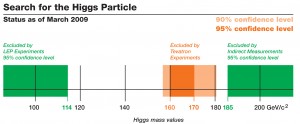
Handy Links
SLAC News Center
SLAC Today
- Subscribe
- Archives: Feb 2006-May 20, 2011
- Archives: May 23, 2011 and later
- Submit Feedback or Story Ideas
- About SLAC Today
SLAC News
Lab News
- Interactions
- Lightsources.org
- ILC NewsLine
- Int'l Science Grid This Week
- Fermilab Today
- Berkeley Lab News
- @brookhaven TODAY
- DOE Pulse
- CERN Courier
- DESY inForm
- US / LHC
SLAC Links
- Emergency
- Safety
- Policy Repository
- Site Entry Form

- Site Maps
- M & O Review
- Computing Status & Calendar
- SLAC Colloquium
- SLACspeak
- SLACspace
- SLAC Logo
- Café Menu
- Flea Market
- Web E-mail
- Marguerite Shuttle
- Discount Commuter Passes
-
Award Reporting Form
- SPIRES
- SciDoc
- Activity Groups
- Library
Stanford
Around the Bay
SLAC and the Higgs
In the 1990s the Stanford Linear Collider and Detector at SLAC produced and studied Z bosons, in tight competition with the Large Electron-Positron Collider, or LEP—the precursor to the Large Hadron Collider at CERN. LEP won out in terms of numbers, collecting about 12 million Z bosons to SLAC's 500,000. But what the SLD couldn't provide in numbers, it made up in technique. In the end, the competition was really a collaboration: the two experiments needed one another to form a complete picture of the Z boson and its properties.
More than ten years later, the work done by SLD and LEP on the Z boson is guiding the search for the Higgs boson at two of largest particle accelerators in the world. The Higgs determines certain properties of the Z boson, and SLD scientists used data on the Z to infer the mass of the Higgs. These indirect measurements done by SLD and LEP are inconsistent with a heavy Higgs, following the Standard Model of particle physics. In essence, this work frames the window in which Fermilab and CERN are now looking for the Higgs.
"The Z boson experiments set the stage for the current Higgs search," says SLAC theorist Michael Peskin, "and the data from SLAC provided some of the strongest constraints."
The Higgs boson theoretically gives mass to all other particles. Locating the Higgs could answer questions about the nature of mass and the interactions of matter. But knowing where to look for this incredible particle took years of theoretical and experimental work, including focus on the Z boson.
The Z boson has a funny preference: it likes lefties. That is, if electrons are polarized to the left, they are slightly more likely to produce Z bosons when colliding with positrons. But circular accelerators like the LEP at CERN quickly wipe out the right or left polarity of an electron. But a linear accelerator like the SLAC linac preserves the polarity. The SLAC collider generated large numbers of right and left polarized electrons to test the Z boson asymmetry. "It is an amazing effect", Peskin explains. "You flip a voltage in a device at the front of the SLAC linac, this flips the polarization of a laser, and three miles away, you see a change in the rate of production of Z bosons."
After seven years of data taking and two more years of analysis, the SLD experiment precisely measured the left/right asymmetry of the Z boson and helped rule out a heavy Higgs.
Evidence narrowing the likely values for the Higgs mass is summarized in a graph from Fermilab, shown above. Measurements of the W boson from LEP and Fermilab's Tevatron, plus additional precision measurements of the Z boson properties from LEP and SLD, all supported the Z asymmetry result. The green bar on the far right of the graph represents the heavy Higgs mass range that the SLD results helped to exclude.
Even with the strong evidence that the Higgs has a mid-range mass, it is still possible that the mass lies outside that window. Peskin explains that the current experimental search for the Higgs is guided by a highly simplified, "minimal" model of the universe that does not include yet undiscovered particles. If there are new particles with masses in the range of one hundred GeV, these can also affect the Z properties. In that case, scientists would have to reevaluate the SLD results, and a heavier Higgs could be a possibility.
Most high-energy physicists believe that many new particles besides the Higgs boson exist—particles from supersymmetry, extra space dimensions, string theory or other models. In some of these models, the Higgs boson would be very heavy, but the LHC could still find it. In others, the Higgs could have a light mass that would hide it from current searches. According to predictions from all of these models, the Tevatron or the LHC will turn up new particles.
"It's possible that [the Higgs] could be in regions of the diagram that are shown as ruled out, if there is more to physics than the Standard Model of the Higgs," says Peskin. "Hopefully, in the next couple of years, we'll find out."
—Calla Cofield
SLAC Today, April 14, 2009
